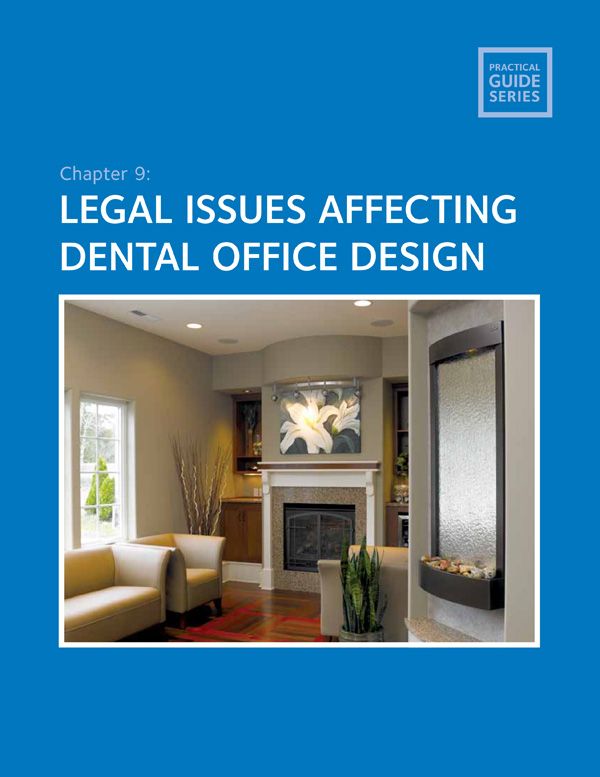Legal Issues Affecting Dental Office Design
By the ADA Legal Division
LEARNING OBJECTIVES
• Become familiar with various laws that affect dental office design
• Understand the importance of working with qualified legal counsel
• Consider the Americans with Disabilities Act from the start of your design plan
• Understand how HIPAA, state data security laws, and payment card industry standards can affect dental office design
• Become familiar with legal issues involving matters such as ergonomics and waste management
Constructing an all-new dental building, remodeling an existing practice’s configuration, or even building out a space not previously used as a dental office requires patience, planning, commitment, investment dollars, and a great deal of vision. An important part of that process involves anticipating and addressing legal considerations. A broad range of legal considerations may be involved, including: civil rights laws; zoning and building codes; laws and standards regulating privacy and data security; contracts with architects and contractors; and many more.
The point of this chapter is not to turn dentists into lawyers, but simply to alert you to a number of legal issues. The information can help educate you as you prepare for your discussions with qualified legal counsel on various legal issues that can arise in connection with such a dental office design project. The goal is to help you be proactive about such matters, rather than wind up in a costly reactive process after the fact, when you may be facing a crisis that could have been averted in the first place. This can include properly shifting the burden of legal compliance to others who will bear responsibility if they take you down an improper path. For example, if someone is going to require you to make extensive alternations to a new dental building because it isn’t “legal,” it certainly makes sense for the person who caused the non-compliance (whether the architect or otherwise) to bear the cost, doesn’t it?
It is important for your design planning to take into account that there is a wide variety of federal, state, and local laws that affect office design.
A variety of laws come into play when designing, altering, or building a dental office. It is important that your dental office comply with all applicable laws. That said, this introductory design book cannot, nor does it purport to, fully address every legal requirement. That is among the many good reasons why it is prudent for dentists involved in developing a new or remodeled office to obtain professional advice from a qualified attorney, and a qualified architect and/or contractor.
The first law that many dentists think about regarding office design is actually a civil rights law, and not a zoning law or building code. At the federal level, the Americans with Disabilities Act (AwDA) imposes minimum requirements regarding accessibility for people with disabilities, and similar state and local laws may impose more stringent requirements. The AwDA is a federal civil rights law, and state or local zoning laws and building codes may impose a wide array of additional requirements for purposes such as safety, as well as for disability access. Zoning laws must typically be addressed in order to commence construction. So, too, many other applicable laws on emerging issues such as ergonomics, data security, and waste management have the potential to shape dental office design requirements. The bottom line: the AwDA may be a good starting point to think about when it comes to dental office design, but there are other laws that come into play.
It is prudent for dentists involved in developing a new or remodeled office to obtain professional advice from a qualified attorney, and a qualified architect and/or contractor.
Examples of Design Issues Affected by Federal, State and/or Local Laws
It is important for your design planning to take into account that there are a wide variety of office design issues that may be affected by federal, state, and local laws, such as:
• Handicapped parking
• Curbs and ramps
• Stairs and elevators
• Doorways and halls
• Door opening force
• Restrooms/toilets
• Public telephones
• Drinking fountains
• Carpeting
• Floor surfaces
• Fixed or built-in seating (with allowance for wheelchair)
• Signage
• Countertop width
• Emergency alarms
• Shelving and coat rack height
• Wall mounted protruding objects in pathways
• Light switch placement
Examples of additional considerations that may be relevant regarding where and how a dental office may be constructed include:
• Zoning
• Land use restrictions
• Environmental laws (e.g. regarding hidden structures such as underground tanks)
• Required easements
• Safety requirements, such as fire protection
• Storm water run-off requirements
• Facility security
• Data safeguards, such as secure storage and disposal
Americans with Disabilities Act
Among other things, the Americans with Disabilities Act helps persons with disabilities access places of public accommodation. For purposes of the Act (and many similar state laws), most dental practices qualify as places of public accommodation, and therefore must comply with the part of the Act related to accessibility. A public accommodation is a private entity that owns, operates, and/or leases or leases to, a place of public accommodation. In other words, the AwDA is not specific to dental offices. It does, however, cover all dental offices that qualify as places of public accommodations, including home offices. Places of public accommodation include a wide range of entities, such as:
• Restaurants
• Hotels
• Doctors’ offices
• Retail stores
• Day care centers
Before addressing what the Act means for dental office design, a word about why it is important to comply. The Act allows private individuals to bring lawsuits in which they can obtain court orders to stop disability discrimination. If an individual sues successfully, the defendant may have to pay the individual’s attorney’s fees. Individuals may also file complaints with the Justice Department, which is authorized to bring lawsuits in cases of general public importance or where a pattern or practice of discrimination is alleged. In these cases, the Justice Department may seek monetary damages and civil penalties up to $55,000 for a first violation, or $110,000 for any subsequent violation. Remedies can be severe, and can include a court order to implement expensive alternations to bring a facility into compliance. It should be noted that in addition to complying simply because it is legally required, compliance can help make your office convenient for all visitors, reduce liability risks, and expand your patient base.
Now that the reasons for compliance with the Act are clear, let’s talk about what you need to do. The Act requires that places of public accommodation, including entry areas, treatment rooms, restrooms, business office, etc. — meet certain accessibility standards.
Let’s take the easiest compliance requirements first — the ones for existing facilities. With limited exceptions, architectural barriers in an existing dental office must be removed to the extent that doing so is “readily achievable,” whether or not the office is planning renovations. The AwDA regulations describe “readily achievable” as something that is “easily accomplishable and able to be carried out without much difficulty or expense.”
To remove barriers, you need to know they exist. And under the law, it is your responsibility to know. A disabilities compliance audit can be helpful in this regard. Information about potential barriers in your office can come from various sources. Perhaps you, your family or friends have disabilities. Maybe patients have made complaints, or you or your staff have watched individuals with disabilities traverse your office with some difficulty, and they may want to contribute their input. It can be valuable, and a good risk management tool, to have a disability rights group help with your audit.
For purposes of the Act (and many similar state laws), most dental practices qualify as places of public accommodation, and therefore must comply with the part of the Act related to accessibility.
Once you’ve identified barriers to access, the focus becomes what types of barrier removal are readily achievable. In most cases, this may include the simple ramping of a few steps, the installation of grab bars where only routine reinforcement of the wall is required, the lowering of telephones, and similar modest adjustments. Other examples of barrier removal that may be considered readily achievable for a private dental office may include:
• Making curb cuts in sidewalks and entrances
• Rearranging furniture
• Adding raised markings on elevator control buttons
• Replacing doorknobs with lever-type openers
The US Department of Justice recommends prioritizing the removal of barriers in existing facilities because you may not have sufficient resources to remove all existing barriers at one time. These priorities are not mandatory, and you are free to exercise discretion in determining the most effective “mix” of barrier removal measures.
The first priority enables individuals to get through the door. It recognizes that providing physical access to a facility from public sidewalks, public transportation, or parking is generally preferable to any alternative arrangements in terms of both business efficiency and the dignity of individuals with disabilities. The second priority is providing access to the areas where goods and services are made available to the public. The third priority is providing access to restrooms (if restrooms are provided for use by customers or clients). The fourth priority is removing any remaining barriers, for example, lowering telephones.
The standard of readily achievable barrier removal does not mean the office must be “full/>
Stay updated, free dental videos. Join our Telegram channel

VIDEdental - Online dental courses




